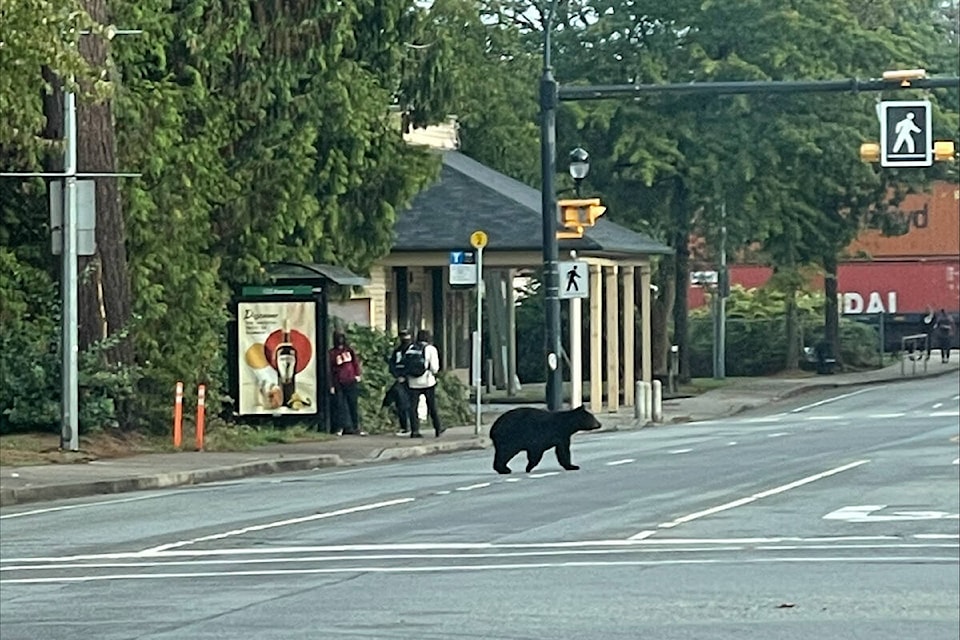A young bear was sighted in Pitt Meadows in the morning hours on Wednesday, and drew concern from parents worried about kids walking to school, as well as from those fearing for the bear’s safety.
According to resident Jason Haycock the bear strolled into a busy scene. It was 8:30 a.m. and the morning commute was in full swing with pedestrians walking to the West Coast Express, people waiting at the bus stop, a few dog walkers, and parents with small children heading to the local school and daycare.
“While waiting for a slow morning train this morning, a black bear strolled out onto Harris Road from Hoffman Park attempting to head east over to the West Coast Express station. The bear and the people standing at the bus stop appeared like it was an everyday occurrence, and the bear almost used the crosswalk before J-walking through stop cars over into the parking lot of Grace Community Church,” said Haycock.
The animal was later spotted at the Chevron gas station, Haycock said.
The bear had come into a backyard first, allegedly attracted to an accessible compost. Reports suggested that the owners of the home then sounded air horns and called the Conservation Officers Service.
In response to the incident, conservation officer Alicia Stark confirmed that a report of a bear-sighting did come to the office. However, she said, unlike the popular belief that if a conservation officer is called after an animal sighting, the animal is put down, no such action was taken.
“This is just false information. We take lots of steps before we could even reach that stage. Putting down a bear is an absolute last option for us,” she said. “We attend to a call either physically or through a phone call and in this case, we got back to the caller through a phone call, and took note of the bear behaviour, size, aggressiveness, etc.”
ALSO READ: Group in Maple Ridge undertakes cleanup to prevent bear-human conflict
Stark also added that the conservation office constantly tried to combat with the belief that one must call a conservation officer only in case of aggressive animal behaviour or about attractants.
“We ask that sightings get reported to us as well, so we can best ensure humans stay safe and bears stay wild,” she said.
WildSafeBC coordinator Dan Mikolay also highlighted why it was important to report bear sightings, and noted it wasn’t right to assume that calling conservation office was a wrong move.
“This is a common misunderstanding. It’s important to know where the bears are in our community, and what brings them there. The goal of WildSafeBC is to keep wildlife wild and our community safe. This is done through awareness and education. Our community is expanding and we are getting new residents from other communities or countries that don’t have an urban bear population. By knowing where the bears are through the WildSafeBC WARP map, we can address attractant issues before the bear becomes habituated,” he said.
To the point of attractants as well, Stark said that while winter was fast approaching, the lower mainland however still had two or three months of active bears, and noted that sometimes the bears don’t even go through hibernation here because of the mild winter.
“But right now, they are still starting to prepare and it is even more important to secure any attractants,” added Stark.
Leah Cooke of a local bear-aware group, Maple Ridge Bears, said that it was people’s responsibility to make sure they didn’t have a negative impact on the wildlife.
“We need to be accountable for the practices we use on our properties, and how those practices impact our native wildlife. Bears are constantly navigating changing landscapes and new developments, and we expect them to adapt but we need to be willing to modify our behaviour-that is a key part to coexistence,” she said.
“Bears are entering hyperphagia, consuming up to 20,000 calories a day in preparation to den. It’s incredibly important that we are not luring bears into neighbourhoods by leaving garbage, compost, bird feeders, and unpicked fruit from trees available. We are the cause and the solution.”
Cooke also said that Maple Ridge Bears would be willing to send homeowners a checklist to help them ensure everyone is part of that solution.
ALSO READ: Conflict with bears still an issue on Maple Ridge hobby farms
Have a story tip? Email: priyanka.ketkar@mapleridgenews.com
Like us on Facebook and follow us on Twitter.
